Rome: Hotel
Places and attractions in the Hotel category
Categories
- Church
- Baroque architecture
- Historical place
- Museum
- Palace
- Sacred and religious sites
- Vernacular architecture
- Architecture
- Street
- Art museum
- Ancient Roman architecture
- Ruins
- Fountain
- Park
- Monuments and statues
- History museum
- Square
- Bridge
- Temple
- Renaissance architecture
- Neighbourhood
- City gate
- Romanesque architecture
- Specialty museum
- Arch
- Theater
- Cemetery
- Catacombs
- Archaeological site
- Historic walking areas
- Concerts and shows
- Sport
- Sport venue
- Giacomo della Porta
- Hill
- Gianlorenzo Bernini
- Art gallery
- Tomb
- Francesco Borromini
- Shopping
- Natural attraction
- Archaeological museum
- Martino Longhi il Vecchio
- Unesco
- Carlo Maderno
- Library
- Carlo Rainaldi
- Spiritual
- Opera
- Arenas and stadiums
- Aqueduct
- Nature
- Modern art museum
- Mausoleum
- Obelisk
- Giovanni Battista Soria
- Giovanni Antonio De Rossi
- Tower
- Forts and castles
- Music venue
- Garden
- Golf
- Hotel
- Gothic Revival architecture
- Nightlife
- Baths
- Amusement park
- Memorial
- Shopping centre
San Carlo al Corso
Sant'Ambrogio e Carlo al Corso is a basilica church in Rome, Italy, facing onto the central part of the Via del Corso. The apse of the church faces across the street, the Mausoleum of Augustus on Via di Ripetta.
Palazzo Cardinal Cesi
Palazzo Cesi-Armellini, sometimes known plainly as Palazzo Cesi, is a late Renaissance building in Rome, important for historical and architectural reasons.
Hotel Dei Borgognoni
The Church of SS. Claudius and Andrew of the Burgundians is a Roman Catholic church dedicated to Saint Claudius of Besançon and the apostle Saint Andrew. It is one of the national churches in Rome dedicated to France. Built from 1728 to 1730, the church was designed by French architect Antoine Dérizet.
Santa Maria in Trivio
Santa Maria in Trivio is a church in Rome. It is dedicated to Mary, mother of Jesus, and is located on Piazza dei Crociferi in rione Trevi. It is near the Fountain of Trevi. In Mariano Vasi's 19th-century guidebook, the church is referred to as Santa Maria a Trevi.
Map




